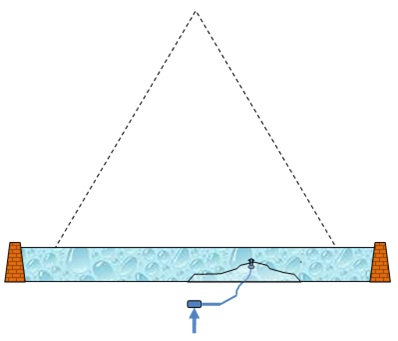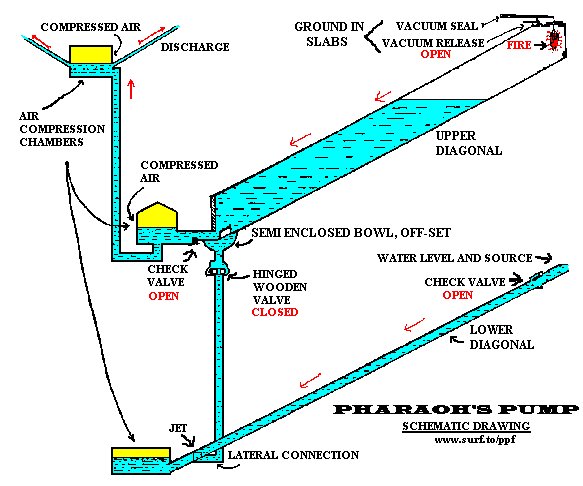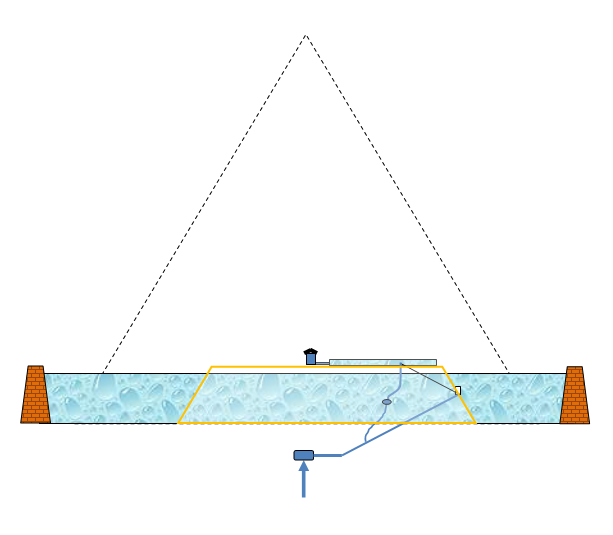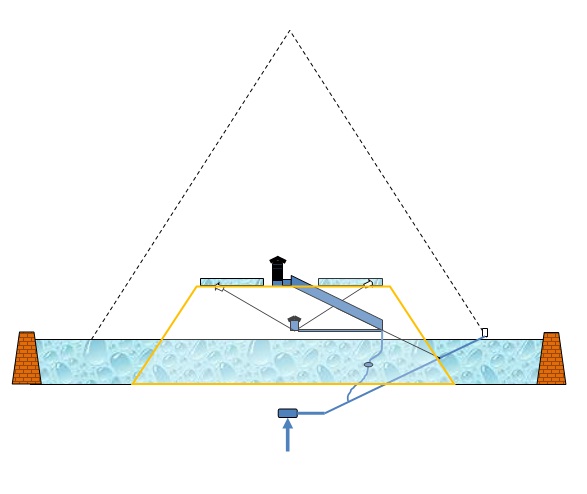How to Build the Great Pyramid
The Construction Stages of Cheops
and
How the Great Pyramid Made Monatomic Gold
and
How the Great Pyramid Made Monatomic Gold
This is an alternative view of the construction of Cheops from The Great Pyramid Rainmaker. It is based on knowledge of how Cheops worked and its purpose as opposed to the third person account related by Herodotus. No researcher has been able to make sense of the currently accepted time frame for good reason; it is wrong.
‘Cheops was built in twenty years’ is repeated so often that it is rarely questioned. It had to have been constructed in a single lifetime in order to fit the tomb view. Scholars try to explain the pyramid with this in mind and invariably fail. This summary highlights the various working stages of the build and the value to the builders. It implies that the structure was probably constructed over many generations.
Several engineers and archaeologists have found evidence of water in and around the Great Pyramid. Here the implications for the building program and the functions are covered briefly. There are five phases outlined, though the pyramid could have received more than one refurbishment between any of the key stages. Each is deduced from the mechanic of the pyramid itself and data that is often overlooked in order to maintain the tomb view.
The five functional phases of Cheops
Here the focus is on how to get the various parts working and what they meant for the builders. Importantly the science of each stage is known and was known to the ancient Egyptians. The various phases were break points where the utility could be exploited for decades before embarking on the next. There is a brief account of each step below. Hopefully it is enough to convince the open minded that Cheops was built over centuries and performed vital functions for long intervals. For a more detailed description read The Great Pyramid Rainmaker.
The Reservoir
The plateau was inhabited long before the pyramids were even conceived. It made a fine refuge from the flooding of the Nile, because of its height and the free flowing ground water. A cold water geyser system functioned where Cheops was eventually to be built. Its sediment raised the natural mound that is still at the core of Cheops.

At this early stage there were no plans for a pyramid, just a need to capture the ground water and store it. The reservoir would allow large numbers of people to permanently settle the site instead of retreating as the water table dropped. To store the water the first settler-constructors built a retaining wall around the natural geyser. This is common to many ancient sites; great reservoirs are always an important facet of settlement.
The permanent settlers could thrive and build drainage channels and canals from the reservoir to convenient transport and irrigation networks. They also received a boost to their income each year as the flood migrants arrived. Ultimately Giza became a central hub of the ancient water network with locks and canals flowing to and from the plateau. This is a common function integrated into many pyramid complexes.
As each canal was dug, there was the natural byproduct of stone. This was used to create the first buildings on the plateau. Again this is a common feature in any pyramid building culture. It did not matter if the canal was dug into dirt or stone, the material was used to form the mass of the pyramids. On the plateau the extracted stone was immediately useful. The canals also provided routes for special stone to be brought in.
The wall is still on the plateau, though no doubt it has had many improvements since the first one was built. It likely started off as relatively small structure and grew to its final stature with time. The current one still has evidence of the overflow conduits. The main problem was that as the water table dropped, the water would back fill the caves beneath the plateau partly emptying the reservoir. A simple solution was needed, which leads to stage two.
The Mastaba Valve
In order to
raise the level of water that could be stored a one way valve had to be
constructed.
It took the form of a simple platform or mastaba. Water flowed to the summit of
the mastaba and then into the reservoir around it.The mound was built up to a raised platform and the structure took the form of a mastaba or stepped pyramid. This is controversial. The affinity for the perfect four sided triangular pyramid is strong in the academic community. It is what makes Cheops such an enigma. However, most pyramids were built over time by adding increasingly larger steps. This is not viable under the tomb time frame, which might explain why it has been rejected. As will be shown, the evidence both physical and textual points to a staged build.
Benefits
The raised platform/pyramid acted as a simple valve. When water flowed to the summit, it could be stored and any excess poured down into the original reservoir. When the water table dropped with the seasons, the reservoir did not flow back into the ground beneath because of the raised inlet. This allowed much more water to be stored and used.
The Man Made Geyser
The Queen’s Chamber was built on the summit of the original platform and a stepped pyramid was built up to the 58th course. With outlet pipes in two directions, the chamber formed a man made geyser cavity. The immense amount of stone was needed to withstand the water pressure and support the summit chambers.
The mechanic of this phase was simple. Carbonated ground water was forced in to the QC by the natural water pressure. When it filled the QC, dissolved gas in the water was released by turbulence and the slight increase in temperature between the cool ground and the chamber. This gas forced the water down the QC and out of the ‘air shafts’. When the gas level reached the exit pipes, it vented in the classic geyser style. This is identical in principle to a soda siphon.
At this point most of the water had been pushed to the summit and the chamber was nearly empty. The pressure had also been decreased due to venting. The ground water pressure was now higher than the chamber’s, this sent water into the chamber and the cycle repeated. This is identical to Kunkel’s method for a single chamber. However, instead of steam being produced by heat, gas trapped in the water was released to provide the force. See Diagram (Blue is indicated by the water, Yellow is the gas).

The remnants in the structure all add to improving this dynamic. The chamber design, the ‘air shafts’ to a previous summit, the solid sealed granite roof slabs and the mass of the structure all have distinct functions. They all contribute to the system.
The water pumping concept is common to other functional models of Cheops. Kunkel uses much the same pattern of support. However, his and all the other models introduce extra parts for the system. Excepting Cadman’s RAM pump, none of them work. Here, nothing needs to be added, except the natural fizzy water and the system will operate. Of course great chunks of the pyramid are removed for this phase, which is just as controversial.
This step pyramid was used in the same way as the other step pyramids. Some are known to have had water reservoirs on their summits and/or reservoirs surrounding them. Akapana and Angkor Wat are both recognized as having water reservoirs on the top level. This short Cheops was no different. It supported sanctuaries built in much the same style as the other step pyramids of Egypt.
Only one sanctuary is shown above, but there were likely the usual arrangement of five sanctuaries on the summit. The function and operation of the sanctuaries is described HERE, they were of great use to the builders. This type of pyramid structure in Egypt is mentioned by writers such as Herodotus, though not in the context of Cheops.
Gravimetric analysis of the structure shows steps up each side. The texts mention ‘battlements’, which implies ledges around the building. There are also references in the Pyramid Texts to a summit where the pharaoh’s body was cremated. None of these features are consistent with a smooth sided peaked pyramid. They are however in line with the more common tiered pyramids found in Egypt and the rest of the world.

Benefits
The gains at this stage include an increase in the volume of water that could be processed and energy independence with the solar aspects. The water was further degassed and warmed as it flowed down the side of the sun heated pyramid. Water and energy are always important factors in any settlement. This water was put to good use on the plateau for a number of industries that emerged. The transport network also grew to maturity at this stage.
This phase also led to the origins of the penultimate Grand Design. There were two factors that evolved from the QC phase. The first and foremost was useful information. Most argue that Cheops was built all in one go, from the ground to the peak. This can not be the case if the structure was a machine because there was no way to know how high the natural water pressure would reach without a phased build. As the structure was built, the maximum water level became clear.
Secondly, a side effect of this stage was the impact of all the falling water. Likewise this could not have been known before the build and operation. No one could even guess at the effect since nothing so large had ever been built before. Water vapor had been seen in the solar chambers, but it was slight and short lived. The vapor was more of an irritant than a goal.
The massive flow of warm water down the side of Cheops led to an amazing insight that was applied with intent in the final working phase. The effect they noted was the mist that formed from the weir on the summit. At any hot geyser or large waterfall this same mist can be seen. It leads to unique weather patterns. The vapor from a geyser/waterfall laces the air with moisture. This causes fog and cloud which in turn makes localized rain. The mist and cloud likely inspired the builders on to the final working stage, where these properties were taken to a higher level.
From Secrets of the Sun Sects @ http://secretsofthesunsects.wordpress.com/2013/10/25/the-construction-stages-of-cheops/ and http://secretsofthesunsects.wordpress.com/2013/10/25/the-man-made-geyser/
How the Great Pyramid Made
Monatomic Gold
See Also; The Pyramid Pump @ http://nexusilluminati.blogspot.com.au/2012/09/the-pyramid-pump-how-great-pyramid.html and http://nexusilluminati.blogspot.com.au/2012/01/new-theory-for-great-pyramid.html
For more information about the Great Pyramid pump see http://nexusilluminati.blogspot.com/search/label/pharaoh's%20pump
For more information about the Great Pyramid see http://nexusilluminati.blogspot.com/search/label/great%20pyramid
- Scroll down through ‘Older Posts’ at the end of each section
New Illuminati comments: While this represents a good outline of construction technique, the Great Pyramid itself was no ad-hoc construction but carefully designed from scratch to serve a number of purposes once erected - see the second video!
Hope you like this
not for profit site -
It takes hours of work every day by
a genuinely incapacitated invalid to maintain, write, edit, research,
illustrate and publish this website from a tiny cabin in a remote forest
Like what we do? Please give anything
you can -
Contribute any amount and receive at
least one New Illuminati eBook!
(You can use a card
securely if you don’t use Paypal)
Please click below -
Spare Bitcoin
change?
Xtra Images – https://farm9.staticflickr.com/8074/8358110254_dacd1af7d0_h.jpg
http://www.icestuff.com/%7Eenergy21/pumpinfo.gif
Videos - http://youtu.be/y6geysnKSJo
http://youtu.be/DQvA-8V9t0Y
http://youtu.be/DQvA-8V9t0Y
For further enlightening
information enter a word or phrase into the random synchronistic search box @
the top left of http://nexusilluminati.blogspot.com
And see
New Illuminati – http://nexusilluminati.blogspot.com
New Illuminati on Facebook - https://www.facebook.com/the.new.illuminati
New Illuminati Youtube Channel - http://www.youtube.com/user/newilluminati/feed
New Illuminati on Google+ @ https://plus.google.com/115562482213600937809/posts
New Illuminati on Twitter @ www.twitter.com/new_illuminati
New Illuminations –Art(icles) by
R. Ayana @ http://newilluminations.blogspot.com
The Her(m)etic Hermit - http://hermetic.blog.com
DISGRUNTLED SITE ADMINS PLEASE NOTE –
We provide a live link to your original material on your site (and
links via social networking services) - which raises your ranking on search
engines and helps spread your info further! This site is
published under Creative Commons Fair Use Copyright (unless an individual
article or other item is declared otherwise by the copyright holder). Reproduction
for non-profit use is permitted & encouraged, - if you give attribution to the work &
author. Please include a (preferably active) link to the original (along with
this or a similar notice).
Feel free to make non-commercial hard (printed) or software copies or
mirror sites - you never know how long something will stay glued to the web –
but remember attribution!
If you like what you see, please send a donation (no amount is too
small or too large) or leave a comment – and thanks for reading this far…
Live long and prosper! Together we can create the best of all possible
worlds…
From the New Illuminati – http://nexusilluminati.blogspot.com



No comments:
Post a Comment
Add your perspective to the conscious collective